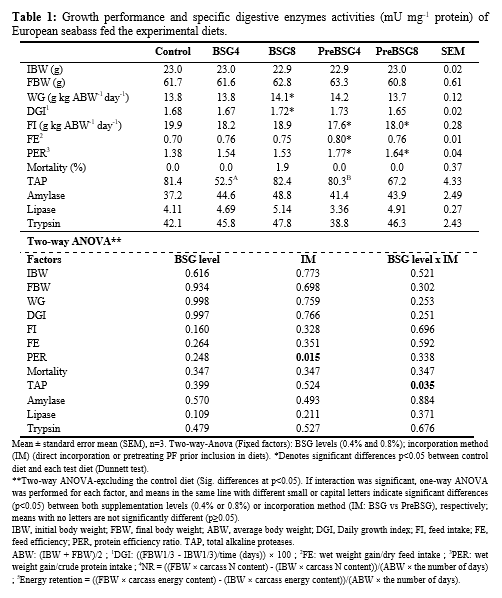ZOOTECHNICAL PERFORMANCE OF EUROPEAN SEABASS Dicentrarchus labrax FED PLANT-FEEDSTUFFS-BASED DIETS PRE-TREATED WITH CARBOHYDRASES PRODUCED BY SOLID-STATE FERMENTATION OF BREWER’S SPENT GRAIN
Introduction
Plant feedstuffs (PF) have non-starch polysaccharides (NSP) that may negatively impact fish growth, feed utilization and nutrients digestion (Kokou & Fountoulaki, 2018). Given the increasing utilization of PF in fish diets as replacers of fishmeal, innovative strategies need to be considered to increase PF nutritional value. One of such strategies is the use of carbohydrases to digest NSP (Castillo & Gatlin, 2015). This work aims to assess the potential of using carbohydrases produced by solid-state fermentation (SSF) of brewer’s spent grain (BSG), either directly incorporated in the diets or used to pre-treat the diet PF mixture, on growth, feed utilization, body composition and digestive enzymes activities of European seabass (Dicentrarchus labrax) juveniles.
Materials and Methods
BSG was fermented (SSF) with Aspergillus ibericus (MUM 03.49) for 7 days, with 75% moisture and at 25 °C. Then, an aqueous extraction was carried out in the fermented product (5 ml distilled water/g fermented BSG) and the enriched-carbohydrases extract was lyophilized. Five isonitrogenous (50% crude protein) and isolipidic (18% crude lipids) diets were formulated to contain 25% fishery products and 55.4% PF: a control diet (with no carbohydrases); two diets similar to the control but inclusing 0.4% (BSG4) and 0.8% (BSG8) lyophilized SSF-carbohydrases, corresponding to 4000 and 8000 U cellulase/kg diet, respectively (28230 and 56460 U xylanase/kg, respectively); two diets similar to the control but with the PF-mixture pre-treated (4 h, 45 °C, 40% moisture) with the lyophilized SSF-carbohydrases in sodium citrate buffer (0.05 N, pH 4.8) at the concentration of 4000 (PreBSG4) and 8000 U cellulase/kg PF (PreBSG8). European seabass (Dicentrarchus labrax) juveniles (IBW 21.5±1 g) were randomly distributed in 18 groups (18 fish/group). The trial lasted 66 days and fish were fed twice a day, 6 days a week. At the end of the trial, fish were bulked weighed and body composition (n=3) and activities of intestinal digestive enzymes (n=9) measured. All experimental diets were compared to the control diet (Dunnett’s test). Two-way-Anova was carried out with BSG levels (0.4% and 0.8%) and incorporation method (IM) (direct or as pre-treatment) as factors.
Results
Compared to the control, fish fed the BSG8 diet showed higher growth, although the PreBSG4 diet also showed similar values but with no significant differences. Further, FI was lower while PER was higher in fish fed both pre-treated diets, and FE was higher in the PreBSG4 group. BSG levels did not affect growth performance and feed utilization of the fish, while pre-treatment of the PF improved PER and NR (% NI) compared to groups fed the diets directly supplemented with the extract. Whole-body dry matter and lipid content were also affected by the inclusion method of SSF-carbohydrases at 0.8%, as BSG8 group presented higher values than PreBSG8 group. Energy body content was similar among groups. Amylase, lipase, and trypsin activities were not affected by diet composition. Total alkaline proteases (TAP) from the 0.4% groups exhibited higher activities when fish were fed the preBSG4 diet.
Conclusions
The use of SSF-carbohydrases promoted the growth and feed efficiency of European seabass juveniles compared to fish fed the control diet. Direct supplementation of 0.8% SSF-carbohydrases in the diet promoted growth performance but did not affect feed efficiency, while pre-treatment of PF with 0.4% SSF-carbohydrases promoted growth performance and decreased feed intake, thus improving feed efficiency.
Acknowledgements: supported by PhD grant by FCT ref. SFRH/BD/131219/2017, IJFCT-POCI-01-0145-FEDER-030377 and MAR-02.01.01-FEAMP-0111
References
Castillo, S., & Gatlin, D. M. (2015). Dietary supplementation of exogenous carbohydrase enzymes in fish nutrition: A review. Aquaculture, 435, 286–292. https://doi.org/10.1016/j.aquaculture.2014.10.011
Kokou, F., & Fountoulaki, E. (2018). Aquaculture waste production associated with antinutrient presence in common fish feed plant ingredients. Aquaculture, 495(October), 295–310. https://doi.org/10.1016/j.aquaculture.2018.06.003
